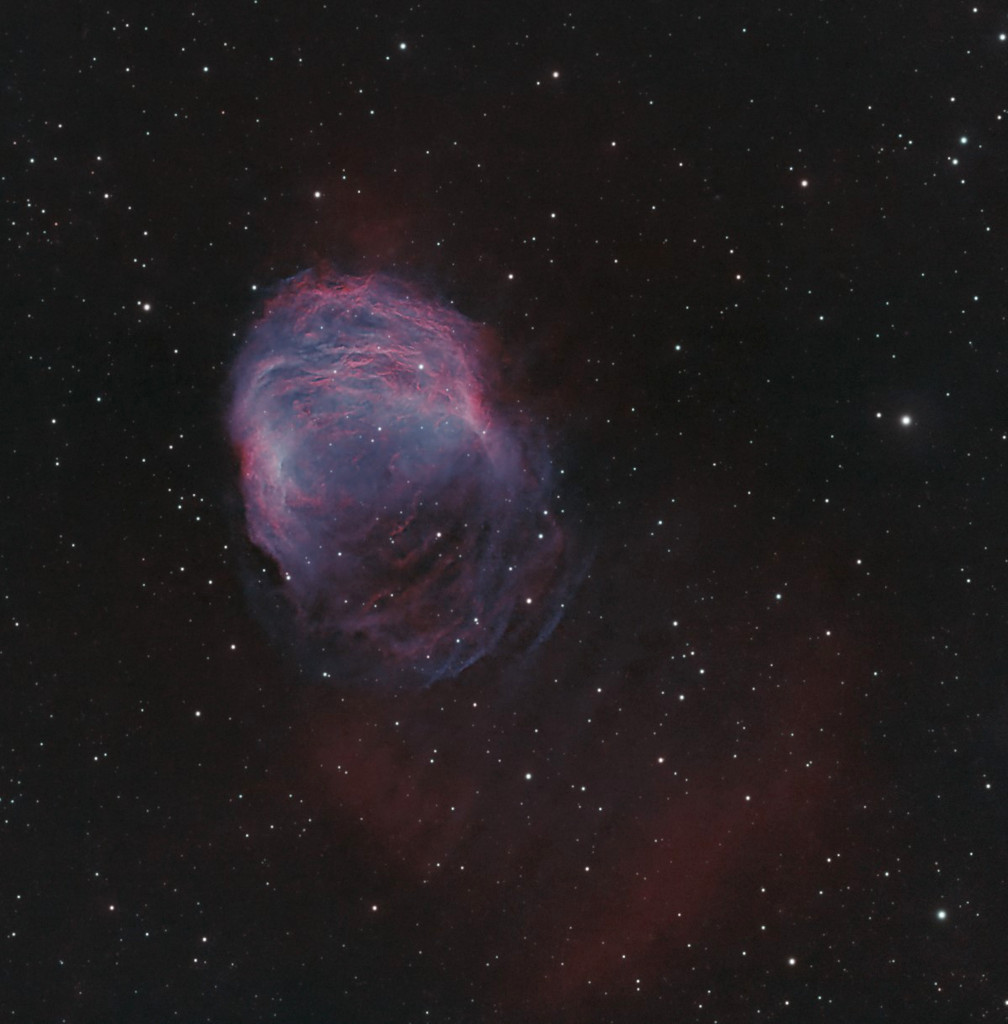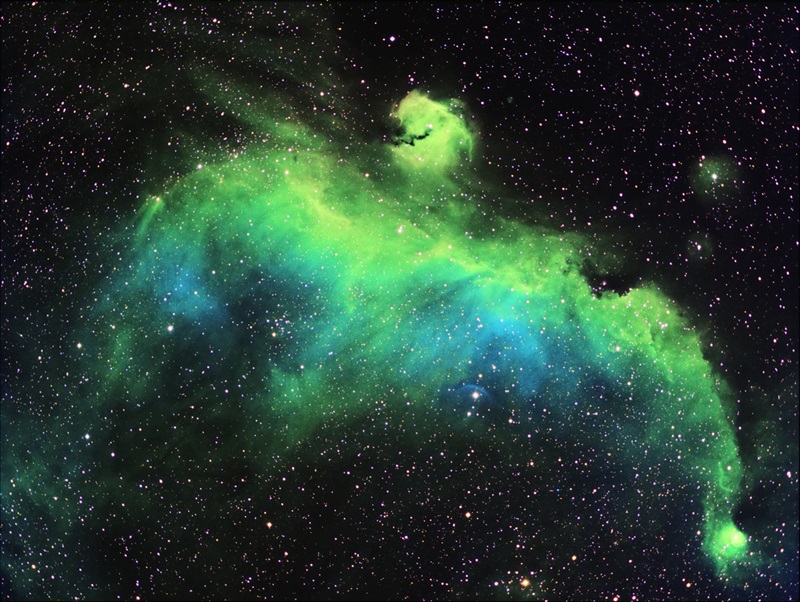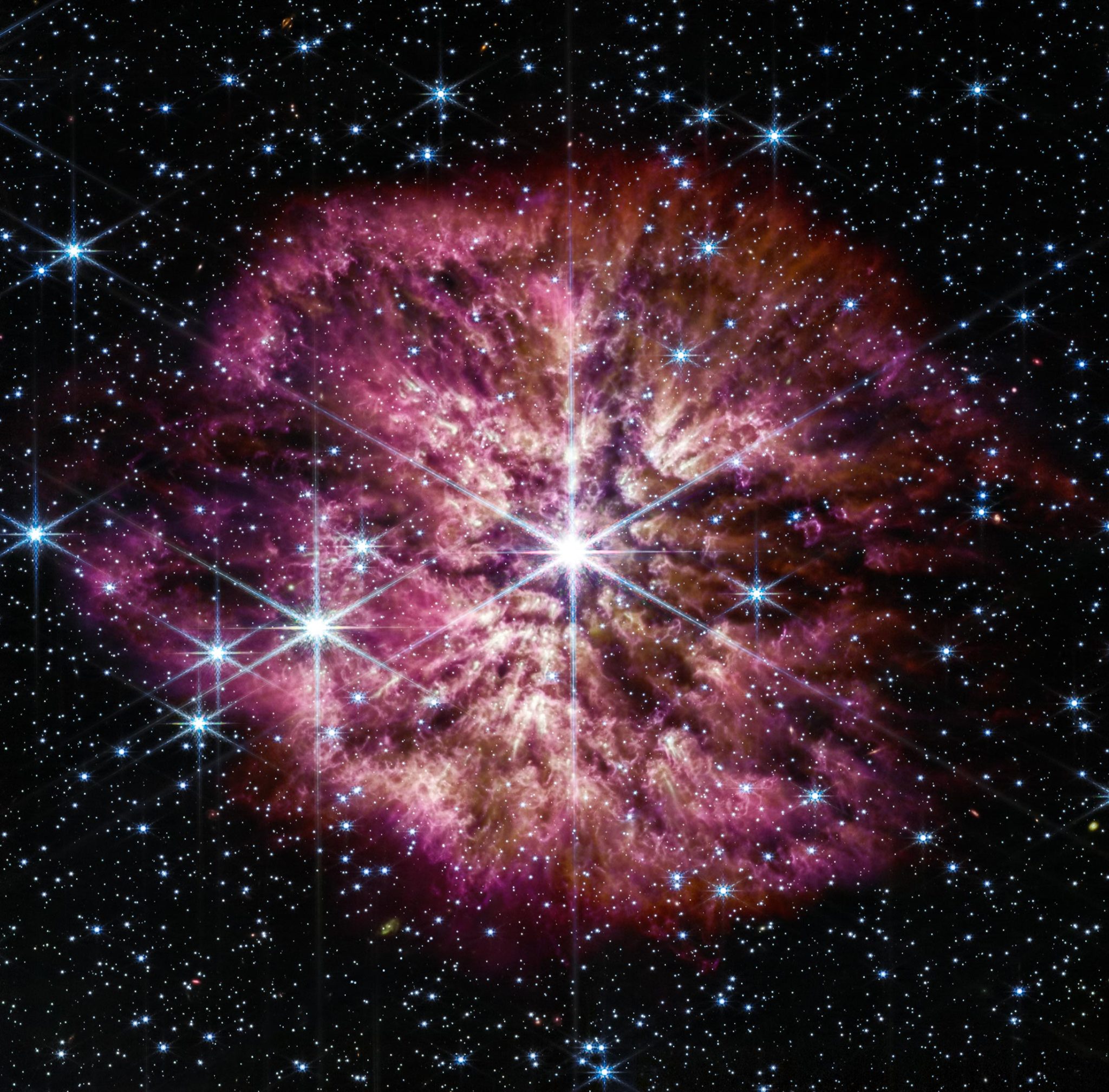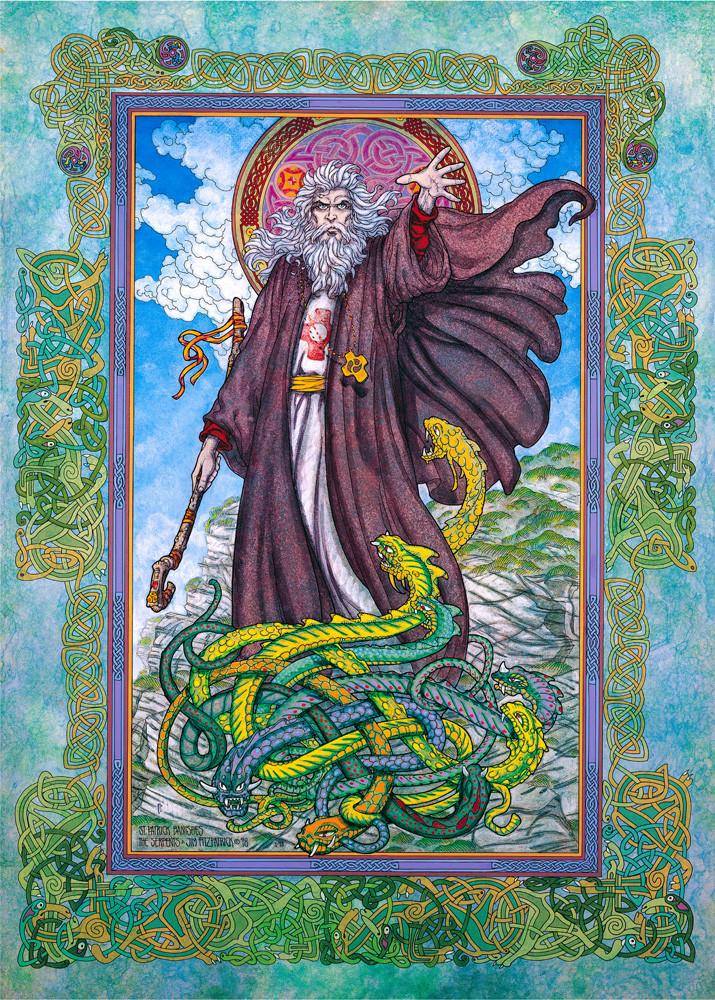Blog

Braided and serpentine filaments of glowing gas suggest this nebula’s popular name, The Medusa Nebula. Also known as Abell 21, this Medusa is an old planetary nebula some 1,500 light-years away in the constellation Gemini. Like its mythological namesake, the nebula is associated with a dramatic transformation. The planetary nebula phase represents a final stage in the evolution of low mass stars like the sun as they transform themselves from red giants to hot white dwarf stars and in the process shrug off their outer layers. Ultraviolet radiation from the hot star powers the nebular glow. The Medusa’s transforming star is the faint one near the center of the overall bright crescent shape. In this deep telescopic view, fainter filaments clearly extend below and right of the bright crescent region. The Medusa Nebula is estimated to be over 4 light-years across.

more...
Andy Narell (born March 18, 1954) is an American jazz steel pannist, composer and producer. Narell took up the steelpan at a young age in Queens, New York. His father, who was a social worker, had started a program of steelpan playing for at-risk youth at the Jewish philanthropic Education Alliance in Lower East Side Manhattan using two sets of pans made by Rupert Sterling, a native of Antigua. Beginning in 1962, Andy, his brother Jeff, and three others boys played on a third set of Sterling-made pans in the basement of the Narell house in the Whitestone neighborhood of Queens, calling themselves the Steel Bandits. The band was a novelty steelpan act that played concerts and appeared on television shows, including I’ve Got a Secret in 1963.
more...William Richard Frisell (born March 18, 1951) is an American jazz guitarist, composer and arranger. Frisell first came to prominence at ECM Records in the 1980s, as both a session player and a leader. He went on to work in a variety of contexts, notably as a participant in the Downtown Scene in New York City, where he formed a long working relationship with composer and saxophonist John Zorn. He was also a longtime member of veteran drummer Paul Motian‘s groups from the early 1980s until 2011 (upon Motian’s death). Since the late 1990s, Frisell’s output as a bandleader has also integrated prominent elements of folk, country, rock ‘n’ roll and Americana. He has six Grammy nominations and one win.
Frisell was born in Baltimore, Maryland, United States, but spent most of his youth in the Denver, Coloradoarea. He studied clarinet with Richard Joiner of the Denver Symphony Orchestra as a youth, but by his teens, was more interested in guitar. He graduated from Denver East High School and went to the University of Northern Colorado to study music. At UNC, he took a class taught by guitarist Johnny Smith. However, Frisell later reported the class effectively became private lessons from Smith because the emphasis on music theory “was too much for everyone else—they didn’t want to be learning scales and inversions.”
more...Wilson Pickett (March 18, 1941 – January 19, 2006) was an American singer and songwriter.
A major figure in the development of soul music, Pickett recorded over 50 songs which made the US R&B charts, many of which crossed over to the Billboard Hot 100. Among his best-known hits are “In the Midnight Hour” (which he co-wrote), “Land of 1,000 Dances“, “634-5789 (Soulsville, U.S.A.)“, “Mustang Sally“, “Funky Broadway“, “Engine No. 9”, and “Don’t Knock My Love“. Pickett was inducted into the Rock and Roll Hall of Fame in 1991, in recognition of his impact on songwriting and recording.
Pickett was born March 18, 1941 in Prattville, Alabama, and sang in Baptist church choirs. He was the fourth of 11 children and called his mother “the baddest woman in my book,” telling historian Gerri Hirshey: “I get scared of her now. She used to hit me with anything, skillets, stove wood … [one time I ran away and] cried for a week. Stayed in the woods, me and my little dog.”[5] Pickett eventually left to live with his father in Detroit in 1955.
more...
Erev Shabbat Service at Temple Israel Friday March 17th 2023 6pm with Cantor Inbal Sharett-Singer, Jayson Rodovsky, Jeff Bailey, Pete Whitman, Ernest Bisong and mick laBriola.
more...
IC 2177 is a region of nebulosity that lies along the border between the constellations Monoceros and Canis Major. It is a roughly circular H II region centered on the Be star HD 53367. This nebula was discovered by Welsh amateur astronomer Isaac Roberts and was described by him as “pretty bright, extremely large, irregularly round, very diffuse.”
The name Seagull Nebula is sometimes applied by amateur astronomers to this emission region, although it more properly includes the neighboring regions of star clusters, dust clouds and reflection nebulae. This latter region includes the open clusters NGC 2335 and NGC 2343.

Paul Lorin Kantner (March 17, 1941 – January 28, 2016) was an American rock musician. He is best known as the co-founder, rhythm guitarist, and vocalist of Jefferson Airplane, a leading psychedelic rockband of the counterculture era. He continued these roles as a member of Jefferson Starship, Jefferson Airplane’s successor band.
Jefferson Airplane formed in 1965 when Kantner met Marty Balin. Kantner eventually became the leader of the group and led it through its highly successful late-1960s period. In 1970, while still active with Jefferson Airplane, Kantner and several Bay Area musicians recorded the album Blows Against the Empire, which was co-credited to both Paul Kantner and “Jefferson Starship”.
Jefferson Airplane continued to record and perform until 1973. Kantner revived the Jefferson Starship name in 1974 and continued to record and perform with them through 1984. He later led a reformed Jefferson Starship from 1992 until his death in 2016. Kantner had the longest continuous membership with the band, with 19 years in the original run of Jefferson Airplane and Jefferson Starship and 24 years in the revived Jefferson Starship. At times, he was the only founding Jefferson Airplane member to remain in Jefferson Starship. He was inducted into the Rock and Roll Hall of Fame as a member of Jefferson Airplane in 1996.
Kantner was born on March 17, 1941, in San Francisco, California, the son of Cora Lee (Fortier) and Paul Schell Kantner. Kantner had a half-brother and a half-sister by his father’s first marriage, both much older than he. His father was of German descent, and his mother was of French and German ancestry. His mother died when he was eight years old, and Kantner remembered that he was not allowed to attend her funeral; his father sent him to the circus instead.
more...Paul Horn (March 17, 1930 – June 29, 2014) was an American flautist, saxophonist, composer and producer. He became a pioneer of world and new age music with his 1969 album Inside. He received five Grammy nominations between 1965 and 1999, including three nominations in 1965.
Horn was born on March 17, 1930, in New York City and had Jewish ancestry through his father. The family moved to Washington, D.C., when Horn was four. He took up the piano at age four, followed by the clarinet at 12. While in Washington, D.C., Horn attended Theodore Roosevelt High School and the Washington College of Music. In the summer of 1942, Horn worked as an usher at the Earl Theatre to buy a clarinet. He studied the clarinet and flute at the Oberlin Conservatory of Music in Ohio, earning a bachelor’s degree. In June 1953, Horn gained a master’s from the Manhattan School of Music.
Moving to Los Angeles, he played with Chico Hamilton‘s quintet from 1956 to 1958 and became an established West Coast session player. He played on the Duke Ellington Orchestra’s Suite Thursday and worked with Nat King Cole, Tony Bennett and others. He scored the 1959 animated television series Clutch Cargo. During the same year he appeared briefly in Roger Corman’s film A Bucket of Blood.
more...Nathaniel Adams Coles (March 17, 1919 – February 15, 1965), known professionally as Nat King Cole, was an American singer, jazz pianist, and actor. Cole’s career as a jazz and pop vocalist started in the late 1930s and spanned almost three decades where he found success and recorded over 100 songs that became hits on the pop charts. He received numerous accolades including a star on the Hollywood Walk of Fame (1960) and a Special Achievement Golden Globe Award. Posthumously, Cole has received the Grammy Lifetime Achievement Award (1990), along with the Sammy Cahn Lifetime Achievement Award(1992) and has been inducted into the Rock and Roll Hall of Fame (2000), and the National Rhythm & Blues Hall of Fame (2020).
Cole started his career as a jazz pianist in the late 1930s, where he formed The King Cole Trio which became the top-selling group (and the only black act) on Capitol Records in the 1940s. His trio was the model for small jazz ensembles that followed. Starting in 1950 he transitioned to become a solo singer billed as Nat King Cole. Despite achieving mainstream success, during his career he faced intense racial discrimination. While not a major vocal public figure in the civil rights movement, Cole was a member of his local NAACP branch and participated in the 1963 March on Washington. He regularly performed for civil rights organizations. From 1956 to 1957, he hosted the NBC variety series The Nat King Cole Show, which became the first nationally broadcast television show hosted by an African American.
Some of his most notable singles include “Unforgettable“, “Smile“, “L-O-V-E“, “Let There Be Love“, “Mona Lisa“, “Autumn Leaves“, “Stardust“, “Straighten Up and Fly Right“, “The Very Thought of You“, “For Sentimental Reasons“, “Embraceable You” and “Almost Like Being in Love“. He is known for his Christmas album The Magic of Christmas (1960) which included “The Christmas Song“; in 1999 it was named by Rolling Stone as one of the greatest Christmas albums of all time. He was the father of singer Natalie Cole(1950–2015), who covered her father’s songs in the 1991 album Unforgettable… with Love.
Nathaniel Adams Coles was born in Montgomery, Alabama, on March 17, 1919. He had three brothers: Eddie (1910–1970), Ike (1927–2001), and Freddy (1931–2020), and a half-sister, Joyce Coles. Each of the Coles brothers pursued careers in music. When Cole was four years old, the family moved to Chicago, Illinois, where his father, Edward Coles, became a Baptist minister.
more...“Seguiriya” is one of the oldest flamenco styles. It is one of the most important with the “bulería” and “soleá”. Etymologically, its name is supposed to derive from the “seguidilla”. A phonetic corruption has deformed it in different terms: “seguiriya”, “siguiriya”, “seguirilla” or “siguerilla”. The oldest evidence of this flamenco style is found in the late 18th century, even though its origin is still uncertain. “Seguiriya” derived from primitive “tonás”, being created between Seville and Cadiz, los Puertos, Jerez and Triana neighborhood. “Livianas” and “serranas” belong to the same group as this style. Both styles follow “segiriya” rhythm. Another variety is the “cabales”, which are very similar to “seguiriyas” but in a higher tone. As singing, it has a tragic and gloomy character, enclosing main values of what is known as “cante hondo”. Lyrics are painful, tragic, about human relationships, love and death. “Seguiriya” has few lyrics and many “quejíos”. Musical aesthetic of “seguiriya” is taken from styles such “malagueñas” or a capella (without guitar). The term “Seguiriya” appears in many literary works. Furthermore, music in some “tonadillas”appear as “seguidilla gitana”, which doesn’t match with “seguidilla flamenca”.
more...The rare sight of a Wolf-Rayet star – among the most luminous, most massive, and most briefly-detectable stars known – was one of the first observations made by NASA’s James Webb Space Telescope in June 2022. Webb shows the star, WR 124, in unprecedented detail with its powerful infrared instruments. The star is 15,000 light-years away in the constellation Sagittarius.
Massive stars race through their lifecycles, and only some of them go through a brief Wolf-Rayet phase before going supernova, making Webb’s detailed observations of this rare phase valuable to astronomers. Wolf-Rayet stars are in the process of casting off their outer layers, resulting in their characteristic halos of gas and dust. The star WR 124 is 30 times the mass of the Sun and has shed 10 Suns’ worth of material—so far. As the ejected gas moves away from the star and cools, cosmic dust forms and glows in the infrared light detectable by Webb.

Pianist Jeter Thompson, whose leadership of the groups Quartette Trés Bien and Trio Trés Bien made him a significant figure on the St. Louis jazz scene from the Gaslight Square era into the 21st century, died on Friday, December 1. He was 87 years old.
Born in St. Louis on March 16, 1930, Thompson started playing piano at five years old, and made his first professional appearance at age 16 in 1946, performing with saxophonist Emmett Carter at a downtown club called the Coconut Grove.
He went to Sumner High School, where in 1948 he was senior class president, and subsequently attended Stowe College for two years, earning an associates degree. He then joined the U. S. Air Force, serving in Korea.
Returning home in 1954, Thompson played various local gigs until the formation in 1959 of Quartette Trés Bien, which in its best-known lineup included bassist Richard Simmons, drummer Albert St. James, and percussionist Percy James.
The group became a popular attraction in the then-booming Gaslight Square entertainment district, serving as the house band at The Dark Side, where in 1962 they were filmed as part of an episode of the CBS drama Route 66.
In 1963, Thompson and his bandmates became partners in the Trés Bien Club, located on the south side of Olive St. near the Gaslight Club. Around that same time, they were approached by Norman Wienstroer to record for his St. Louis-based label Norman Records.
The group made two albums for Norman, Boss Trés Bien and Kilimanjaro, and in 1965 also backed singer Jeanne Trevor on her debut recording for the label. Wienstroer subsequently helped the Quartette gain the attention of Decca Records, which re-issued their first two albums and would release eight more recordings of them over the next few years.
With an assist from fellow St. Louisan Dick Gregory, whose standup comedy career was peaking at the same time, Quartette Trés Bien also became a touring band. They appeared with Gregory at the Apollo in Harlem; on a bill with Thelonious Monk at the It Club in Los Angeles (where Monk would make a famous live recording for Columbia Records); and as headliners at storied jazz spots of the 1960s including the Plugged Nickel in Chicago, Baker’s Keyboard Lounge in Detroit, Crawford’s Grill in Pittsburgh, The Lighthouse in Hermosa Beach, CA, and many others.
more...Jerry Jeff Walker (born Ronald Clyde Crosby; March 16, 1942 – October 23, 2020) was an American country music and folk singer-songwriter. He was a leading figure in the progressive country and outlaw country music movement. He was best known for having written the 1968 song “Mr. Bojangles“.
Walker was born Ronald Clyde Crosby in Oneonta, New York, on March 16, 1942. His father, Mel, worked as a sports referee and bartender; his mother, Alma (Conrow), was a housewife. His maternal grandparents played for square dances in the Oneonta area[4] – his grandmother, Jessie Conrow, playing piano, while his grandfather played fiddle. During the late 1950s, Crosby was a member of a local Oneonta teen band called The Tones.
more...Fred Neil (March 16, 1936 – July 7, 2001) was an American folk singer-songwriter active in the 1960s and early 1970s. He did not achieve commercial success as a performer and is mainly known through other people’s recordings of his material – particularly “Everybody’s Talkin’“, which became a hit for Harry Nilssonafter it was used in the film Midnight Cowboy in 1969. Though highly regarded by contemporary folk singers, he was reluctant to tour and spent much of the last 30 years of his life assisting with the preservation of dolphins.
Fred Neil was born Frederick Ralph Morlock Jr., in Cleveland, Ohio, just two weeks after his parents, Frederick Ralph Morlock and Lura Camp Riggs, married. Neil later said that he took his stage name from his maternal grandmother, Addie Neill, the family member of whom he was fondest. While they lived in Ohio, his father installed sound systems for the Automatic Musical Instrument Distribution Company (AMI), which made player pianos and, later, jukeboxes, and then worked for the Triangle Music Company, distributor of Aireon jukeboxes. In 1942, the Morlock family moved to St. Petersburg, Florida, where young Fred started singing when he was in first grade, coached by his mother, she claimed. Around 1947, when in sixth grade, he started playing guitar. His parents had separated in 1945, divorcing in 1949, and his father returned to Cleveland.
more...More Posts
- Illegal Immunity
- Impoverished Reality
- Frank Frost
- Cosmo M77
- Jeff Golub
- Michael Kamen
- Richard Davis
- Annapurna Devi
- Herb Pomeroy
- World Music Rafozako Mamolava
- Daily Roots The Royals
- KARIBUNI Benedictine Living performance
- Cosmo Center of Milky Way
- Ritchie Blackmore
- Mbuta Matima
- Michael Brewer
- Ali Akbar Khan
- Gene Ammons
- World Music KARIBUNI
- Daily Roots The Crystalites
